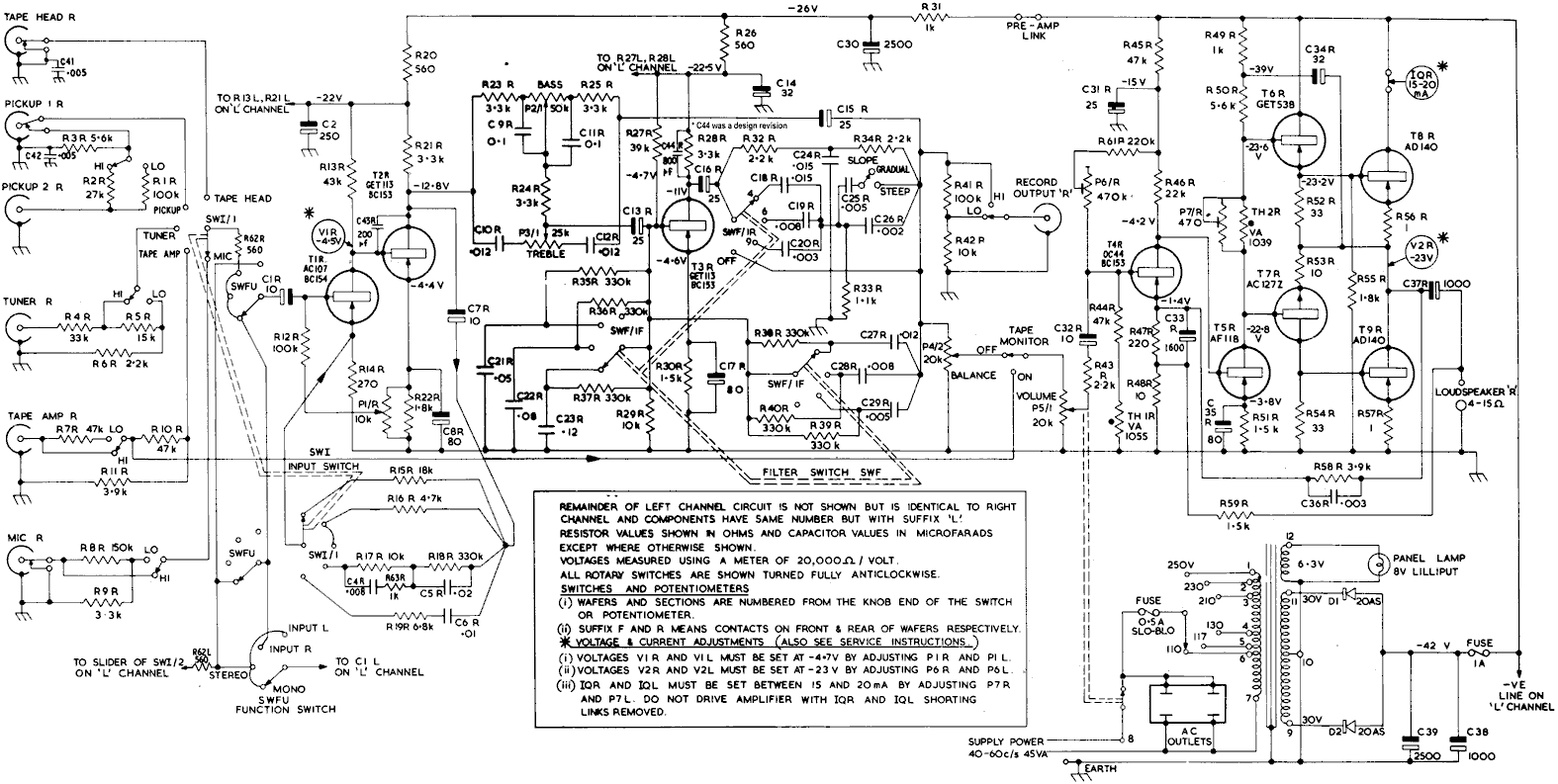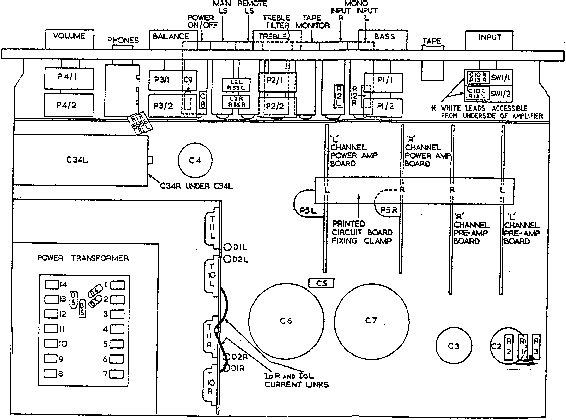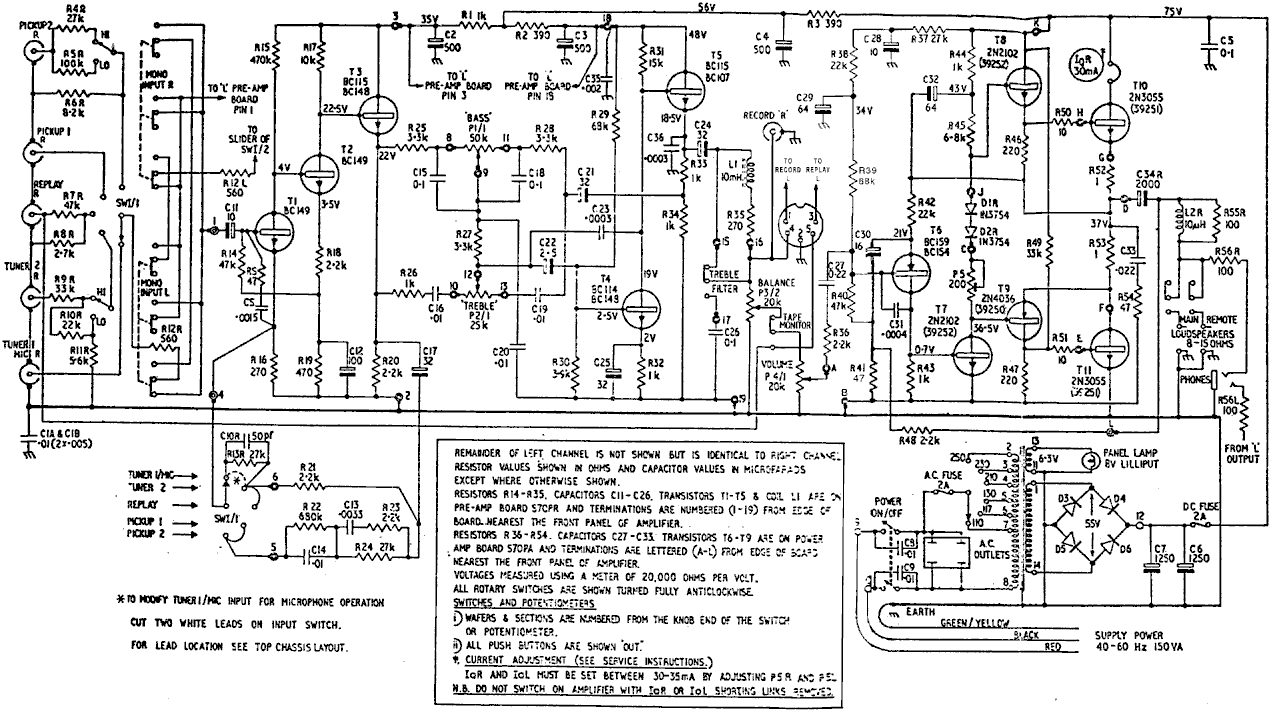

Leak Stereo/Delta amplifiers.Building on the success of his thermionic designs Harold Leak produced a solid-state model, the 'Stereo 30', using germanium technology. The (sophisticated for it's time) filter gave roll-offs at 9, 6 and 4kHz, the 'Gradual' position giving a 12dB slope and the 'Steep' position 20dB. Similarities between this and later designs (bar polarities!) can be seen, bearing more than a passing resemblance to the Dinsdale MkII. An excellent source for Leak service manuals can be found here. These (although lacking in spec, especially for valve) can give useful insights into usage and are recommended, given the limitations here.


A striking feature, for the author, are the large values of the electrolytics used to decouple the preamp supply rail (2m5F) and the power amp feedback (1m6F), whilst a thermistor reduces the power amp input resistance with temperature.The silicon Leak Stereo 30 Plus (below) and 70 amplifiers were the last models produced when the company was still owned by Leak. After acquisition by Rank, the Delta range of units were produced, but these were essentially derived from the Stereo designs. The Delta 30 and Delta 70 were simply the older Stereo 30 Plus and Stereo 70 models with minor improvements, the 30 Plus adopting the plug-in board arrangement of the 70.
The sound quality of all these models was, at the time, held to be good, the more complex treble filter being replaced by a single 6kHz (12dB per octave). This might have been due to customers complaining about the apparent ineffectiveness of the 9 and 6kHz positions in the Stereo 30 when the fault apparently lay with the restricted responses of other equipment. Improvements, in terms of gain and headroom, were made to the input stage and the power amp's feedback but the extensive, flexible but inevitably noisy input switching was retained. It was felt that this detracted from the design since it must have been obvious with experience that having both + and - inputs of the preamp's input directly connected in series to multiple mechanical contacts was a bad idea. For example, an improvement would have been made if the function switching, if even necessary, had preceded the balance, and the feedback switches wiper had been wired to the input stage's output.


The Leak Delta 70 was manufactured from '73 to '78, and even appeared as the Wharfedale Linton integrated amplifier. Using the same chassis and identical plug-in preamp and driver boards, the 70's beefier power supply and output transistors offered twice the 30's output, despite the very limited (improved!) heat-sinking.Modular approaches had been used in the '67 to '69 Armstrong 400 and later 500 series. This was intended to make the systems flexible to manufacture and meant that any units sent for repair could often be ‘fixed’ quickly, faulty boards being replaced by less experienced staff. These would then be repaired later by qualified engineers to be reused. Unfortunately, the PCB connectors could corrode (often because of acids in finger-prints left by production workers) and give rise to failures. Non-functional units using this form of construction can often be restored if attention is given to these and the many mechanical contacts in the signal paths. The Stereo 70 is shown below.


The Delta 75 tuner was a copy of the older Stereofetic tuner notable for employing two FM IF IC amplifiers (CA3011) and a high-reliability IC (CA3026) dual independent differential array in it's MPX decoder as a phase detector (due to limitations of commercial grade?), but with a relatively poor AM section compared to, say, some Armstrong designs. This was a vast improvement on, say, the three transistor decoders used in the Troughline tuners which were plagued by an IF instability probably introduced by ill-trained production workers, or poor quality control (thus the label 'trough-like', as in pig, that arose in some quarters). Differences were obvious in the power amp section which gave a similar specification to that in the 70.
Apart from the proven performance of the relatively sophisticated FM section a number felt that the 75 was disappointing. Note how the transistor symbols have changed in the schematics to the more conventional form.Overview: innovation was not a Leak byword. Many engineers at the time had military experience or training and, if allowed, could demonstrate what could be achieved if commercial constraints were ignored. Leak showed that a commercial success could be made by simply adhering to tried and tested methods. The credit for originality must lie elsewhere.
Contact me
especially if you want additional content to this page
or if you find any links that don't work. Don't forget
to add the page title or URL. Take care!
Back to index, sound, tips or home.